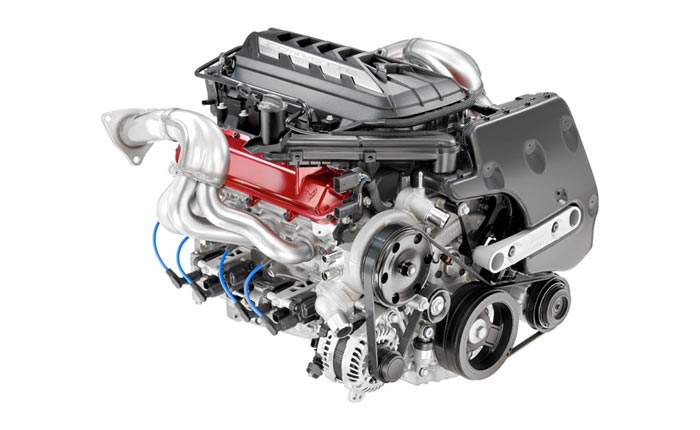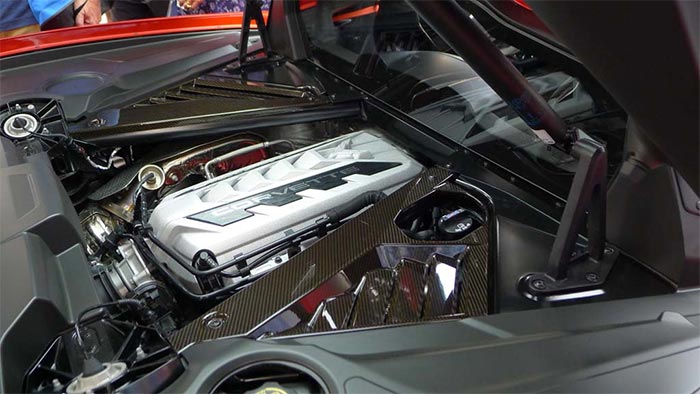To a Corvette enthusiast, the new LT2 engine visible through the rear glass of the 2020 mid-engine Stingray is a beautiful piece of engineering to see.
But the new powerplant – though it has the same displacement and remains naturally aspirated, like its predecessor in the C7 – represented a much different challenge – and opportunity – for the Corvette team.
First of all, since the engine is no longer mounted in the front of the Corvette, forward visibility was no longer a concern for the engineers, meaning they could use a taller intake manifold that increased in size considerably, to 14.1 liters from 11.1 liters.
The engine also is able to produce 3 percent more power at higher RPMs, thanks to the use of runners that are now of the same length, an impossibility with the LT1 used from 2014 to 2019.

Chevy also redesigned the camshaft with a different profile, and a one-millimeter larger exhaust valve lift matching the intake lift results in additional flow that leads to more power.
Other key ingredients to helping the LT2 become the most powerful base engine ever offered in a Corvette were a new wide-range air-fuel sensor (WRAF) that helps the engine idle smoothly and reduces emissions by 25 percent; a completely new design for the exhaust using new 4 in 1 headers with primary runners of almost the same length; new catalytic converters with one per bank instead of the two used in the old LT1 engine; and a new dry-sump oil system for better lubrication, especially at high speed, and better oil pressure while requiring less oil and making the engine lighter.
All these improvements add up to a 0 to 60 time of 2.9 seconds for the new LT2 engine, which delivers a whopping 495 horsepower and 470 lb-ft of torque.
Source:
Chevrolet
Related:
[VIDEO] Wards Auto Highlights the C8 Corvette’s LT2 Engine That Was Named a Top 10 for 2020
How C8 Corvette Designers and Engineers Collaborated to Showcase the LT2 V8 Engine
The 2020 Corvette Stingray Goes 0-60 MPH in 2.9 Second
-


![[VIDEO] Here is Everything We Know About the 21 C8 Corvette ZR1 Prototypes Already Built [VIDEO] Here is Everything We Know About the 21 C8 Corvette ZR1 Prototypes Already Built](https://www.corvetteblogger.com/images/content/uploads/2024/04/041924_4-218x150.jpg)
![[VIDEO] 2024 Corvette E-Ray Bullies a Nissan GTR and a Lamborghini Aventador SV at the Drag Strip [VIDEO] 2024 Corvette E-Ray Bullies a Nissan GTR and a Lamborghini Aventador SV](https://www.corvetteblogger.com/images/content/uploads/2024/04/041824_3-218x150.jpg)
![[VIDEO] More Quarter Mile Action with the All New 2024 Corvette E-Ray [VIDEO] More Quarter Mile Action with the All New 2024 Corvette E-Ray](https://www.corvetteblogger.com/images/content/uploads/2024/04/041824_2b-218x150.jpg)
Reference the last paragraph ….. “All these improvements add up to a 0 to 60 time of 2.9 seconds for the new LT2 engine, which delivers a whopping 495 horsepower and 470 lb-ft of torque.”
The LT2 is a terrific engineering achievement, no question, no doubt.
Albeit, we all know one of the goals of Corvette Team was a 3 sec., or more zealous, sub-3 sec., 0-to-60 time. That could not have been accomplished with a curb weight of around 3535LBS, and the LT2’s 495HP, with a “conventional” final drive ratio. That dog wouldn’t hunt. To be sure, Tadge and company computed, calculated and did simulations to figure out exactly just what rear axle ratio would be needed in order to achieve the C8 planned goal.
There is more to the equation for the C8s great acceleration times than just more hp/torque, and a rear weight bias providing better traction.
Specifically, it has much to do with the C8s ridiculously high numerical, low gear, base-4.89, and Z51-5.17 final drive axle ratios. And, no question, no doubt, utilization of these rear axle ratios could not have happened without the 8 speed DCT. 4th gear of the DCT is a .8-1, vs a typical 1-1.
Comparing the C8 to my C6 2013 man-trans Grand Sport, the performance of which I am familiar with, the C6 GS 0-to-60 time is right around 3.8. That is attained with a lower numerical, higher gear, 3.42 final drive ratio. The power-to-weight ratio of my GS is around 7.7, the C8 is around 7.2. Those power-to-weight numbers are not that disparate as to afford the C8 a one second+/- faster 0-60 time. Albeit, a 5.17 final drive ratio is.
I would venture to say if the C8 were equipped with a “more conventional” 3.42 final drive, the times would be closer to my GS 3.8 sec. than they are the 3.0 sec. as advertised, probably around 3.5 sec., give or take. Still fast, but not what Corvette Team was ‘gearing’ for [pun intended].
At my age, 73, I recall when 4.10s and 4.56s were the final drive ratios of choice for drag racing. Holy kryptonite, a base-4.89 and a Z51-5.17 are RADICAL in comparison. Heck, given an abundantly high numerical, low gear, final drive ratio, I could get my Suburban to run a 3! But the fuel mileage would be cause for me to take out a home equity.
Just sayin’.
I’m a sucker for the 2nd gen.
Agree about the gearing ratios, great for drag racing, but for me, the greatest thing about the LT2 is the very real dry sump oiling system. It has 3 scavenging pumps to remove oil from the engine and pump it to a correctly designed oil tank with swirl baffles . Then it has another pressure pump that draws oil from the bottem of the tank to the engine. This is the same system used in high dollar racing machines for years. No more dropping oil pressure in corners. Way better than Past corvettes with the damp sump 2 pump system.
Comments are closed.